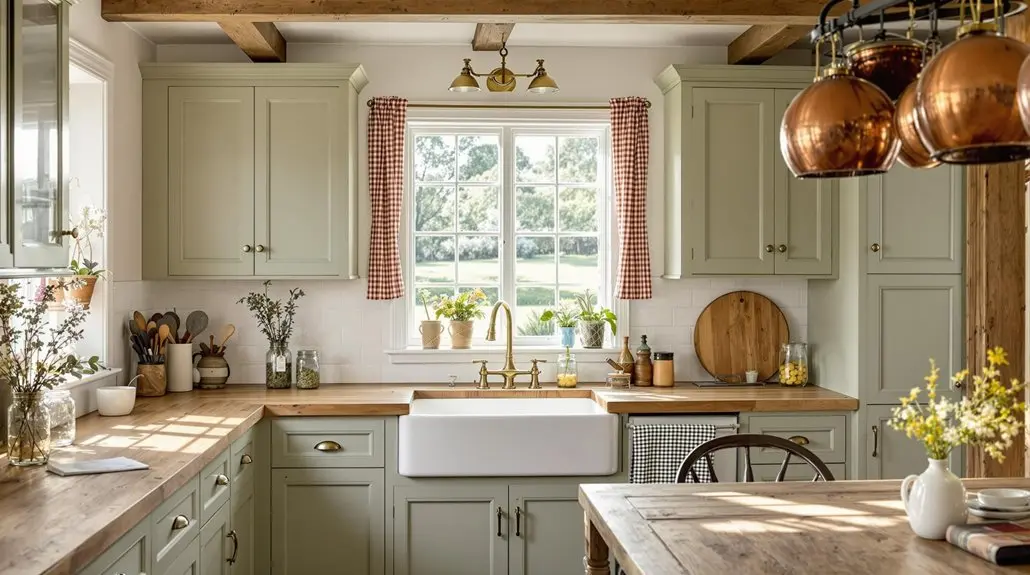Farmhouse green kitchens evoke a cozy, authentic ambiance through layered shades of sage, olive, and forest hues grounded by rustic elements like exposed wood and textured tile. Sage green cabinets paired with natural wood or brass fixtures offer visual balance, while botanical wallpaper and curated open shelving add dimension. Contrasting forest green cabinetry with crisp white surfaces maintains brightness and highlights focal features. Discover expert inspiration on combining vintage accents, natural greenery, and thoughtful materials to craft harmonious, inviting kitchen spaces.
Key Takeaways
- Layer sage, olive, and forest green tones across cabinets, walls, and accents for depth and a naturally cozy farmhouse feel.
- Pair green cabinetry with warm wood countertops or beams to balance cool hues and add rustic authenticity.
- Use open shelving with green pottery and textured ceramics to create inviting, curated displays that enhance farmhouse charm.
- Add contrast with white or quartz countertops and brass fixtures, brightening the space while maintaining vintage appeal.
- Incorporate botanical wallpaper, potted herbs, and vintage kitchenware for vibrant, personalized touches that keep the kitchen feeling fresh and lived-in.
Embracing Sage Green Cabinets for a Soft Rustic Look
While contemporary trends increasingly favor natural palettes, sage green cabinets have emerged as a foundational element in farmhouse kitchen design. This soft hue provides a calming, grounding presence, harmonizing seamlessly with rustic elements such as exposed wood beams or stone countertops.
Regarding visual balance, sage green cabinetry introduces warmth without overpowering the space, enabling a cozy farmhouse aesthetic that feels inviting yet sophisticated.
The versatility of this shade is evident; it pairs well with neutral backdrops like white or cream walls and supports a range of accent colors, from earthy terracottas to muted golds.
To enhance the serene environment in the kitchen, consider pairing sage green with brass or gold hardware for a touch of elegance.
Functionally, sage green cabinets act as a neutral, allowing for flexible decor choices and seasonal updates, all while maintaining a timeless, cohesive look that bridges rural charm with modern sensibility.
Layering Green Tones for Depth and Interest
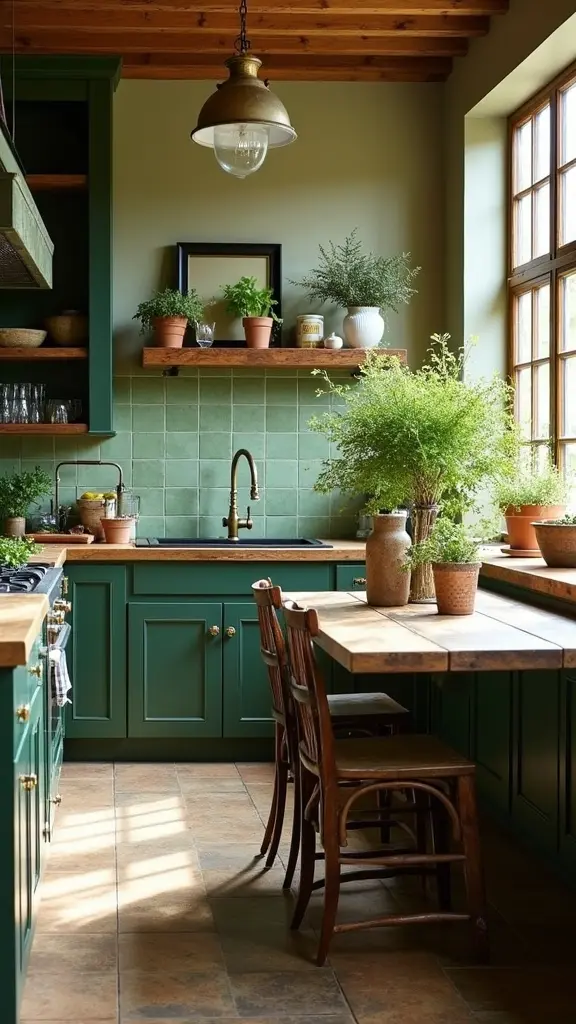
A thoughtful layering of green tones introduces nuanced depth and visual intrigue to the farmhouse kitchen. This design strategy leverages the interplay between dark green kitchen cabinets, soft sage walls, and olive green accents to prevent visual monotony and establish a sophisticated color narrative.
By layering different shades of green, designers achieve a harmonious yet dynamic environment that emphasizes both contrast and cohesion. The integration of natural textures further enhances this effect, creating an authentic and inviting atmosphere.
Layered green tones and natural textures bring harmony, depth, and a welcoming authenticity to the farmhouse kitchen environment.
Key applications include:
- Pairing dark green kitchen cabinets with soft sage backsplashes to delineate work zones.
- Utilizing olive green as a neutral backdrop, supporting organic materials like wood and stone.
- Incorporating light green accents and natural textures, such as woven baskets, for added warmth and visual balance.
Mixing Vintage Fixtures With Olive Green Accents
Pairing antique lighting fixtures with olive green cabinet highlights establishes a dynamic interplay between historical reference and contemporary color palettes.
The patina of vintage brass pendants or sconces provides visual contrast against the matte, earthy tones of olive cabinetry, achieving cohesion through thoughtful juxtaposition.
This approach prioritizes both ergonomic illumination and stylistic integrity, ensuring the kitchen remains inviting and highly functional.
Pairing Antique Lighting Fixtures
How does one achieve an authentic farmhouse aesthetic in the kitchen? The key lies in the harmonious interplay between antique lighting fixtures and olive green accents. This pairing not only establishes a warm and inviting atmosphere but also enhances the vintage aesthetic central to farmhouse design.
For a balanced and functional layout, consider the following expert guidelines:
- Select Statement Lighting: Choose antique fixtures—wrought iron chandeliers or vintage pendants—featuring brass finishes or a weathered patina to echo historical charm.
- Coordinate Color Palettes: Align olive green accents with the metal tones of the fixtures to create visual cohesion and reinforce an earthy, grounded ambience.
- Layer Light Sources: Incorporate multiple fixtures at varying heights to distribute light evenly, encouraging both task efficiency and a cozy, welcoming environment.
Olive Green Cabinet Highlights
With antique lighting fixtures setting the tone for a vintage-inspired kitchen, olive green cabinetry emerges as a sophisticated anchor that unifies the space.
The warm, earthy hue of olive green serves as an inviting backdrop, expertly complementing vintage fixtures such as brass hardware and retro pendants. This color’s versatility allows it to function as a neutral foundation, fostering cohesion with natural wood accents and textured materials—think weathered countertops or a classic farmhouse sink.
Open shelving seamlessly integrated with olive green cabinets enables curated displays of vintage kitchenware, enhancing both character and functionality.
The interplay of olive green, natural wood, and vintage fixtures achieves a balanced visual narrative, allowing for the introduction of patterned dishware or botanical accents while preserving a cozy, authentic farmhouse ambiance.
Creating Contrast With Forest Green and White
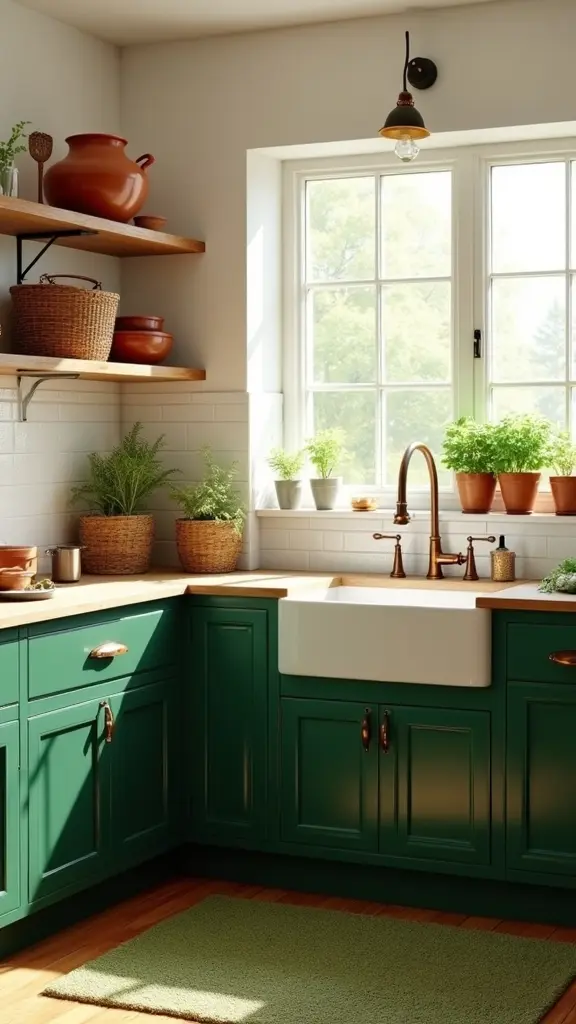
Strategically pairing forest green cabinetry with crisp white surfaces achieves a balanced interplay between boldness and brightness, establishing a harmonious visual rhythm in the space.
This high-contrast scheme naturally draws attention to focal features such as statement islands or classic farmhouse sinks.
Incorporating quartz countertops in white or light tones further accentuates the cabinetry, unifying the palette while enhancing both function and elegance.
Balancing Bold and Bright
When deep forest green cabinetry is juxtaposed with crisp white paneling, a sophisticated visual contrast emerges that enhances the farmhouse kitchen’s aesthetic. Achieving a balance between bold and bright is essential for a timeless, cozy farmhouse environment.
The interplay of these hues creates a dynamic yet harmonious atmosphere, preventing either color from overpowering the space. Ideal visual balance and functional layout can be accomplished by:
- Integrating light-hued quartz countertops to provide a clean shift between forest green and white, maintaining a fresh, inviting ambiance.
- Utilizing coordinated fixtures—such as matte black or brass—ensures visual continuity and accentuates the deliberate contrast.
- Allocating ample white surfaces in compact kitchens to counterbalance the depth of forest green, sustaining airiness and preventing visual congestion.
This duality infuses the kitchen with enduring character and sophistication.
Highlighting Focal Features
Contrast serves as the cornerstone of an effective farmhouse green kitchen, where carefully positioned focal features anchor the design.
Forest green cabinetry establishes a dramatic visual base, while crisp white accents—such as paneling, trim, and shelving—introduce brightness and delineate architectural elements. This interplay of color guarantees that kitchen features remain visually distinct and that the space avoids becoming overly saturated or dim.
Incorporating natural textures, like exposed wood beams or matte metal hardware, further enriches the aesthetic, contributing both tactile interest and authenticity.
Functional layout is enhanced by grouping these contrasting elements, allowing each zone to serve a practical purpose while maintaining a cohesive, inviting atmosphere.
Ultimately, this thoughtful use of color and material generates a cozy farmhouse feel rooted in visual balance and comfort.
Accentuating With Quartz Countertops
Building on the interplay of deep green cabinetry and crisp white accents, quartz countertops introduce a refined layer of contrast that enhances both visual balance and functionality in the farmhouse kitchen.
The pristine surface of quartz countertops juxtaposes the saturated tones of forest green cabinetry, solidifying a timeless color scheme rooted in sophistication and warmth. The light-reflective properties of quartz amplify the natural brightness, ensuring the overall layout feels open and welcoming.
- Contrast and Color Harmony: White quartz counters ground the deep green palette, delivering a harmonious yet dynamic visual statement.
- Durability and Maintenance: Quartz’s resilience supports the demands of a busy farmhouse kitchen, preserving its aesthetic integrity over time.
- Texture and Visual Interest: Selecting a textured quartz finish accentuates the rustic charm, adding depth without overwhelming the design.
Adding Botanical Wallpaper for Farmhouse Charm
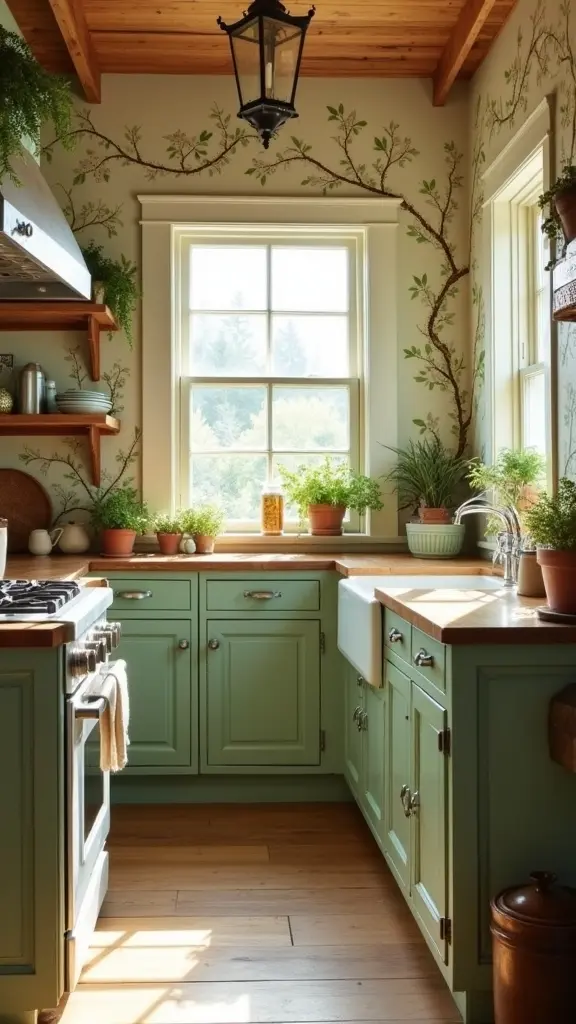
A thoughtfully selected botanical wallpaper introduces vibrant organic motifs into a farmhouse kitchen, fostering a seamless connection to nature while enhancing visual harmony.
Botanical wallpaper featuring green hues complements green cabinetry, reinforcing a cohesive color scheme that feels both intentional and timeless.
The strategic placement of botanical patterns, particularly on accent walls, can create a focal point that draws the eye and balances the visual weight of natural wood elements and white surfaces.
Peel-and-stick options offer flexibility, allowing for updates without extensive renovation.
Intricate floral designs reference traditional craftsmanship, lending authenticity to the farmhouse aesthetic.
When integrated thoughtfully, botanical wallpaper enhances the kitchen’s ambiance, providing texture and depth while celebrating the interplay between nature-inspired decor and the functional layout of a welcoming space.
Inviting Warmth With Wooden Countertops and Green Hues
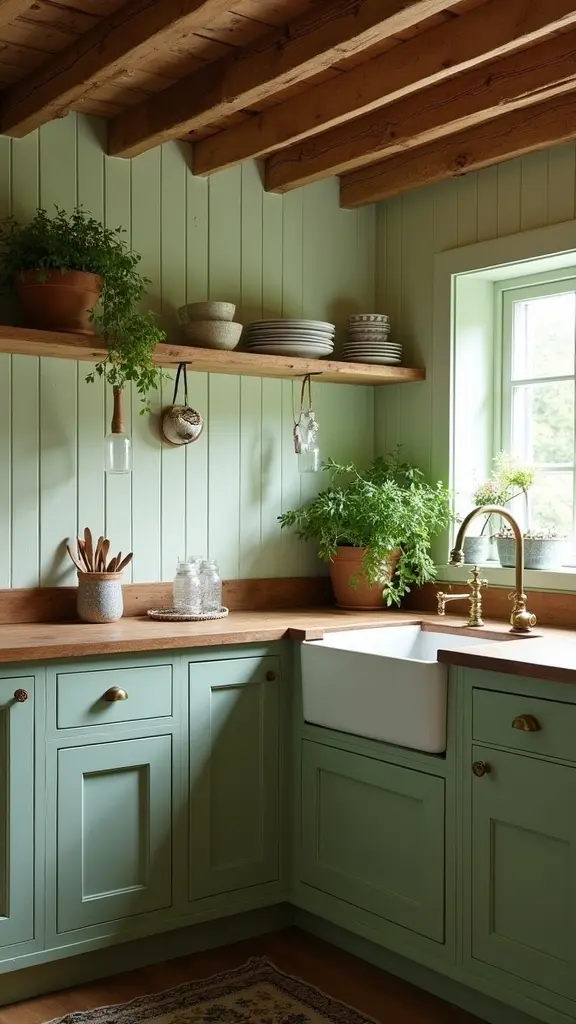
Pairing green cabinetry with wooden countertops establishes a harmonious visual contrast that underscores both warmth and authenticity in a farmhouse kitchen.
The interplay of wood grain texture against calming green hues enhances tactile interest while reinforcing a cohesive, inviting atmosphere.
Strategically incorporating various green shades with wood surfaces contributes to functional zoning without sacrificing the overall sense of comfort and unity.
Pairing Green With Wood
When green hues are combined with wooden countertops, the farmhouse kitchen gains an organic sophistication that bridges rustic tradition with contemporary design.
The interplay between green cabinetry and warm wood surfaces establishes a visual balance that enhances both aesthetic and function. Earthy shades such as sage or olive coordinate seamlessly with butcher block islands and exposed beams, encapsulating cozy, rustic charm.
The juxtaposition of cool green tones with the inherent warmth of wood cultivates a grounded, inviting ambiance well-suited for family living.
- Green cabinetry paired with natural wood shelving maintains a harmonious palette, anchoring the space authentically.
- Warm wood butcher block countertops amplify the tactile appeal and complement earthy green accents.
- Strategic placement of wood elements—like beams or trim—reinforces cohesion, ensuring a unified and functional kitchen environment.
Enhancing Warmth Through Texture
Building on the interplay between green cabinetry and wood, tactile elements become central to enhancing the farmhouse kitchen’s warmth. Wooden countertops introduce organic texture, their grain patterns and natural tones complementing green hues and reinforcing the farmhouse aesthetic. Sage green cabinetry, paired with textured elements such as butcher block or reclaimed wood surfaces, produces a nuanced visual balance—each material accentuating the other’s depth and authenticity. This synthesis of materials not only amplifies coziness but also underscores craftsmanship and simplicity inherent in farmhouse design. The following table illustrates the textured and chromatic layering that defines this approach:
| Element | Visual Effect |
|---|---|
| Wooden Countertops | Inviting organic warmth |
| Green Hues | Earthy, calming ambiance |
| Textured Elements | Depth and tactile interest |
| Sage Green Cabinetry | Authentic farmhouse charm |
Incorporating Green Appliances for a Playful Touch
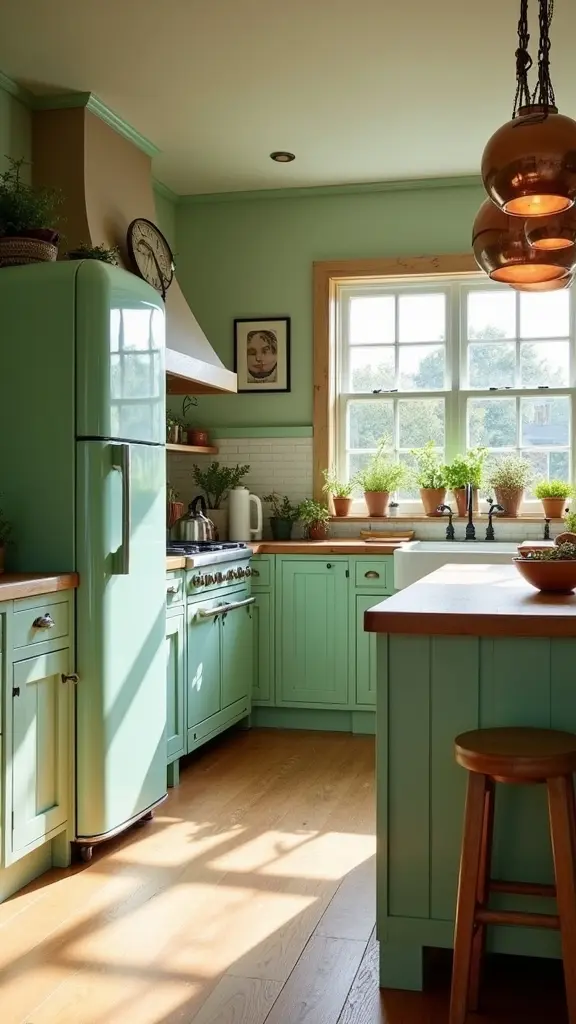
Although farmhouse kitchens often favor neutral tones and timeless materials, introducing green appliances—such as a retro-inspired refrigerator or range—instantly injects a playful, distinctive focal point into the space.
Green appliances seamlessly bridge nostalgic charm and modern efficiency, contributing both to aesthetic vibrancy and sustainability. To achieve visual balance and functional layout in a farmhouse kitchen, consider these expert recommendations:
- Select Complementary Shades: Opt for greens like olive or mint to harmonize with the existing color palette, ensuring cohesion with cabinetry and countertops.
- Prioritize Eco-Friendly Choice: Seek out appliances featuring energy-efficient technology, aligning playful touch with sustainable kitchen design.
- Strategic Placement: Position green appliances as a centerpiece to draw the eye and create dynamic contrast, reinforcing a cozy yet spirited farmhouse atmosphere.
Styling Open Shelving With Green Kitchenware
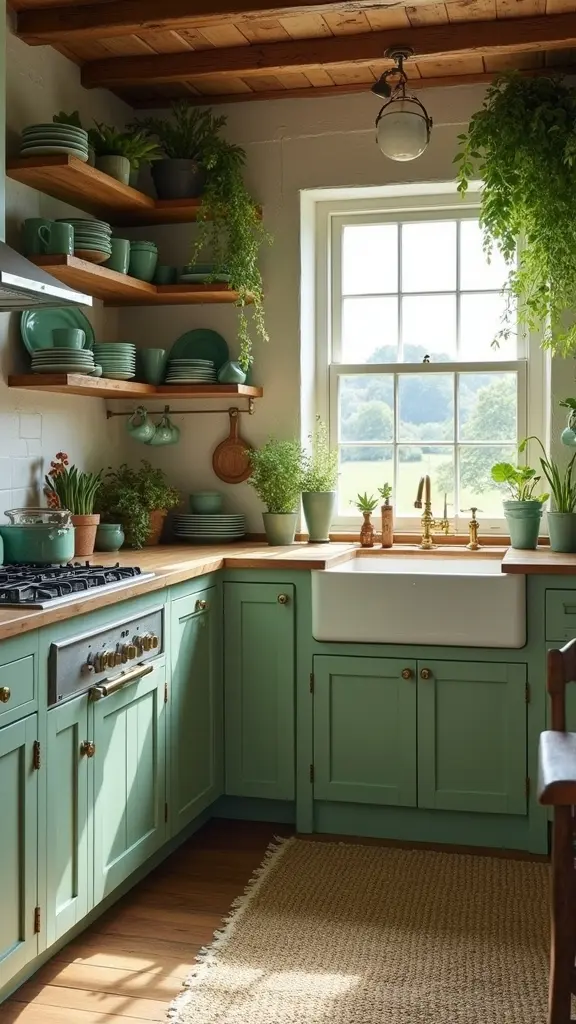
Effective styling of open shelving with green kitchenware begins by curating collections in a spectrum of tonalities, from olive to sage, to establish visual harmony.
Integrating textured ceramics and wooden or metal accents introduces tactile contrast, while interspersing neutral pieces guarantees spatial equilibrium and prevents monotony.
Strategic placement of kitchenware by size and shape, alongside greenery in matching pots, results in a cohesive and functional display.
Curating Greenware Collections
When thoughtfully curated, greenware collections on open shelving serve as both functional storage and a visual focal point, unifying the farmhouse kitchen with layers of verdant hues.
The deliberate selection of green kitchenware introduces a spectrum of tones—from soft sage to deep emerald—creating visual interest that enhances the space.
Incorporating botanical patterns or live plants alongside these collections strengthens the farmhouse aesthetic, echoing natural motifs and fostering a cozy, authentic ambiance.
Strategic arrangement is key for both balance and accessibility.
Consider the following approach:
- Combine varied green kitchenware, such as plates, bowls, and glassware, for tonal diversity.
- Integrate botanical patterns or greenery to reinforce a nature-inspired theme.
- Stagger item heights and positions, optimizing open shelving for both function and aesthetic cohesion.
Mixing Textures and Materials
Careful juxtaposition of varied textures and materials transforms open shelving in a farmhouse green kitchen into a curated showcase of style and utility.
Expertly arranged green kitchenware—ranging from matte ceramic dishes to glossy glass jars—anchors the open shelves with visual balance and functional accessibility.
Integrating natural materials, such as wooden cutting boards and woven baskets, introduces tactile contrast, reinforcing the authentic farmhouse ambiance.
Layering multiple shades of green kitchenware, from delicate mint to robust olive, produces depth and intrigue while maintaining a cohesive display.
Clear glass containers, used for pantry staples or fresh herbs, contribute both transparency and structural order.
Accents like green-patterned tea towels or compact potted plants add further dimension, ensuring the open shelving remains both aesthetically compelling and practically organized.
Balancing Color and Space
How does one achieve equilibrium between vibrant color and spatial clarity on open shelving in a farmhouse green kitchen? The answer lies in curating green kitchenware and natural materials to create visual balance while preserving a cozy feel.
Layering different shades, from mint to olive, prevents monotony and adds depth. Incorporating textured green pottery introduces tactile interest, while wooden or wicker accents ground the composition in authenticity.
To optimize both color harmony and spatial arrangement, consider the following:
- Layering different shades – Arrange kitchenware in gradients, mixing light and dark greens for dynamic contrast.
- Integrating textured green pottery – Use ceramics with varied finishes to amplify dimension and warmth.
- Blending natural materials – Balance green hues with organic wood or woven elements for a cohesive, inviting aesthetic.
Pairing Pastel Greens With Classic Shaker Cabinets
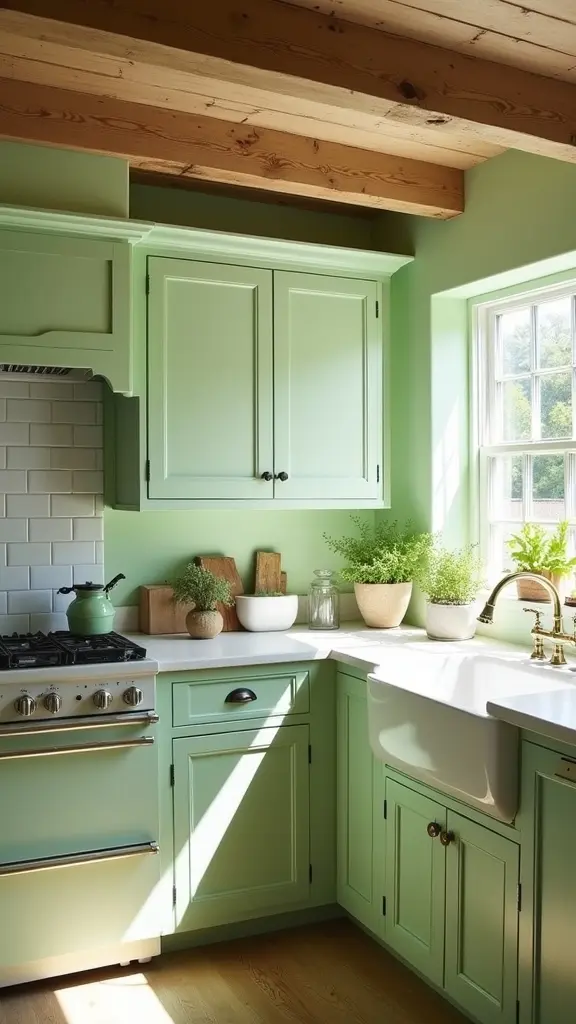
Why does the combination of pastel greens and classic Shaker cabinets resonate so strongly in farmhouse kitchen design? This pairing achieves a harmonious balance between modern softness and time-honored craftsmanship. Pastel greens, such as mint or sage, lighten the Shaker cabinets’ visual weight, introducing an airy quality that enhances the sense of space without sacrificing warmth. The understated lines of Shaker cabinetry allow these subtle shades to feature prominently, contributing to a timeless look. When natural wood accents—like butcher block countertops or open shelving—are integrated, the space gains rustic charm and authenticity. Pairing pastel greens with classic white paneling or backsplash tiles further boosts the farmhouse aesthetic, creating a cohesive environment. The combination of sage green and white creates a fresh, modern vibe in kitchens, enhancing the overall farmhouse appeal.
Highlighting a Green Kitchen Island as a Focal Point
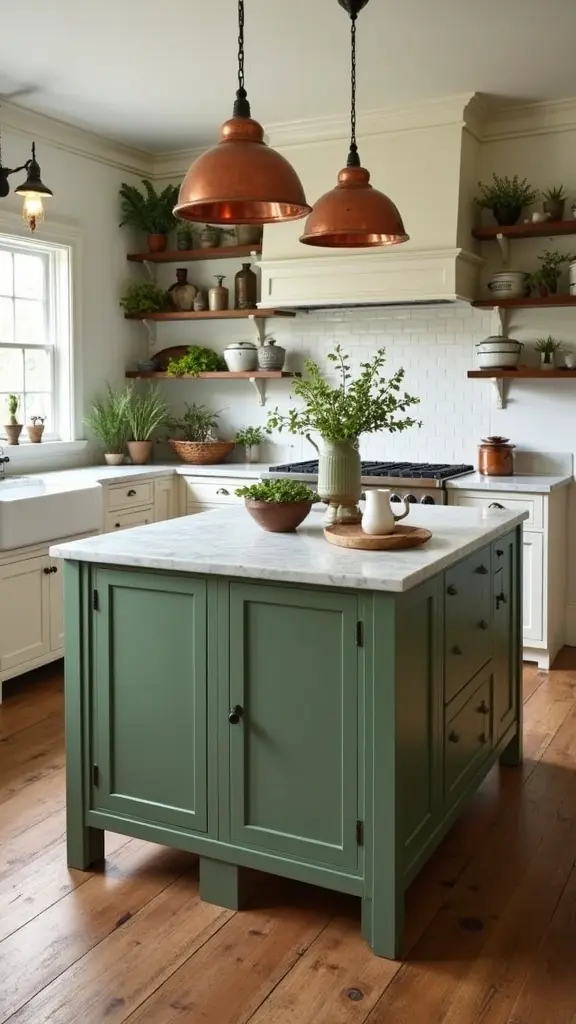
A green kitchen island introduces a dynamic focal point within farmhouse-inspired spaces, anchoring the room through both color and form. The strategic use of a bold green kitchen island not only energizes the overall layout but also enhances the cozy atmosphere typical of a farmhouse kitchen.
Visual contrast is achieved when the green island is set against neutral cabinetry or natural wood, producing a harmonious yet striking effect. Expertly integrating decorative elements and thoughtful materials further lifts the design:
- Pairing the green kitchen island with contrasting colors, such as crisp white or light oak, amplifies visual depth.
- Incorporating textured countertops—like butcher block or stone—maintains warmth and authenticity.
- Arranging pendant lighting, greenery, and artful bar stools around the island enriches its function as a welcoming gathering point.
Using light sage for cottage-inspired design adds a cozy, vintage charm to the overall aesthetics, further enhancing the farmhouse feel.
Combining Brass Details With Deep Green Cabinets

Building on the visual impact of a green kitchen island, the interplay between deep green cabinetry and brass details further refines the farmhouse aesthetic.
Deep green cabinets act as a saturated, inviting backdrop, while brass hardware—such as knobs and pulls—introduces a warm metallic accent, creating a sophisticated yet approachable environment.
Deep green cabinets paired with brass accents create a warm, sophisticated atmosphere that feels both vintage and modern.
This combination delivers vintage charm, referencing historical farmhouse design, yet remains rooted in a modern look through clean lines and thoughtful spatial arrangement.
Brass light fixtures, strategically positioned, enhance the cozy atmosphere by casting a gentle glow against the rich cabinetry.
Incorporating brass shelving brackets or decorative accents contributes visual balance and textural depth, ensuring that the kitchen feels cohesive and curated.
For a nature-inspired atmosphere, incorporating botanical elements like fresh herbs and potted plants can enhance the calming effect of green cabinetry.
The result is a space that is both timeless and aligned with contemporary design trends.
Using Green Tiles for a Refreshing Backsplash
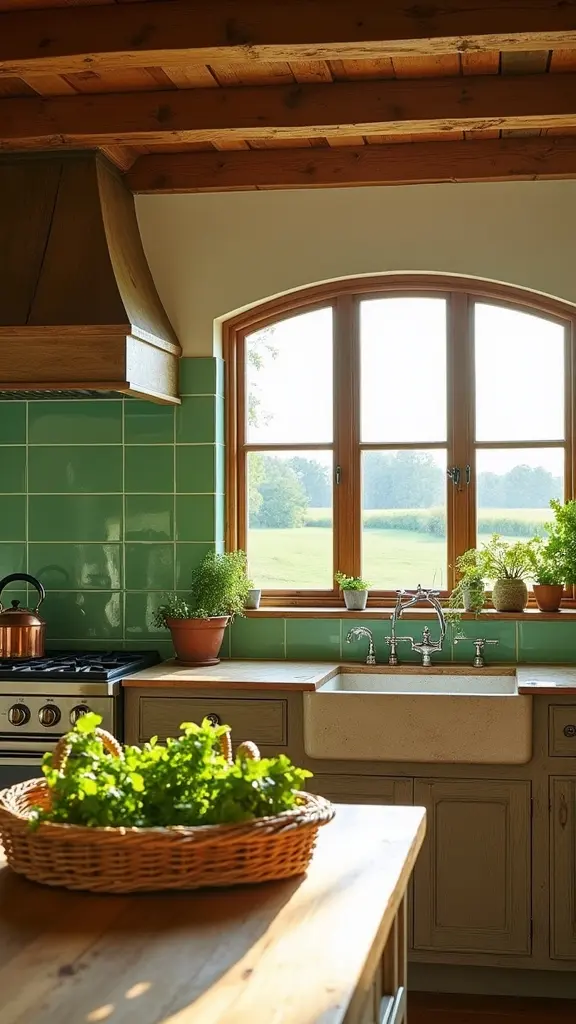
While subtle in application, green tiles introduce a dynamic layer to the farmhouse kitchen by serving as a revitalizing backsplash that unifies rustic charm with modern color sensibility. Employing green tiles as an invigorating backsplash creates a focal point that balances the authenticity of natural materials with a light and airy palette. Expertly selected, these tiles—ranging from soft mint to deep olive—offer dimensionality and visual intrigue. Textured varieties, such as zellige or handcrafted options, contribute artisanal warmth, enhancing the kitchen’s cozy character. For ideal visual balance and functional integration, consider:
- Mixing shades and finishes of green tiles for depth and complexity;
- Pairing the invigorating backsplash with wood or stone countertops to reinforce a harmonious, natural look;
- Choosing lighter greens to amplify brightness and airiness.
Green-on-green sage tile ideas can create a harmonious connection to nature, enhancing the serene ambiance of your farmhouse kitchen.
Introducing Plants and Fauna for a Natural Vibe
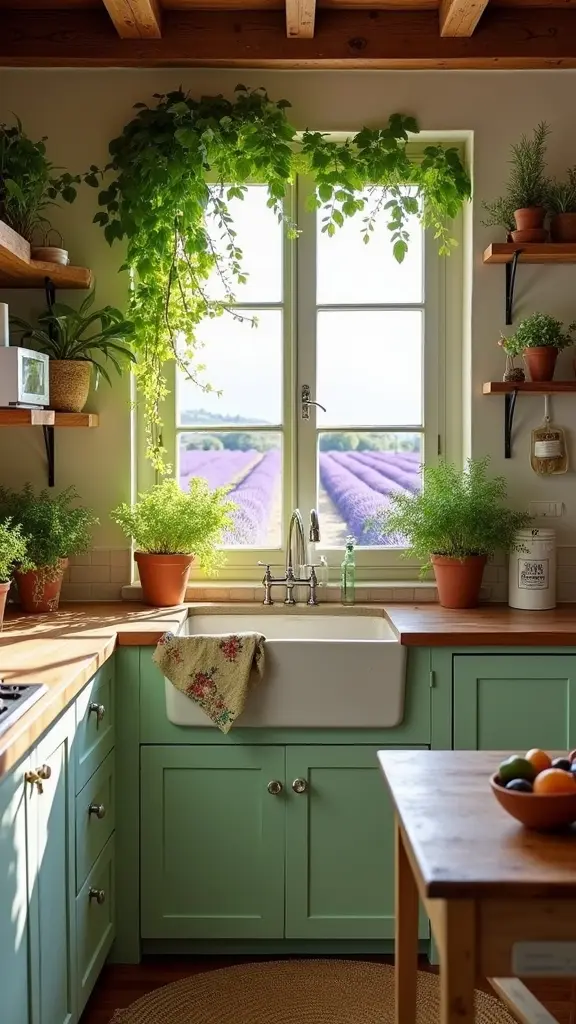
Incorporating plants and subtle fauna motifs introduces organic importance to a farmhouse green kitchen, seamlessly bridging indoor spaces with nature’s tranquility. Strategic placement of potted herbs—such as basil, rosemary, and thyme—on windowsills or countertops not only enriches green kitchen ideas aesthetically but also enhances culinary functionality by offering fresh flavors at arm’s reach. To optimize spatial efficiency, designers often recommend hanging planters or wall-mounted shelves, creating vertical gardens that add dimension without overcrowding. Selecting low-maintenance plants like pothos or snake plants guarantees enduring vibrancy with minimal upkeep, aligning with practical farmhouse sensibilities. Authenticity is further reinforced by integrating natural materials such as wooden plant stands and terracotta pots, grounding the space and accentuating the rustic undertones characteristic of a welcoming farmhouse kitchen environment. Additionally, incorporating sustainable materials such as FSC-certified wood or recycled glass enhances the kitchen's eco-friendliness while maintaining a natural aesthetic.
Balancing Soft Green Walls With Cozy Textures
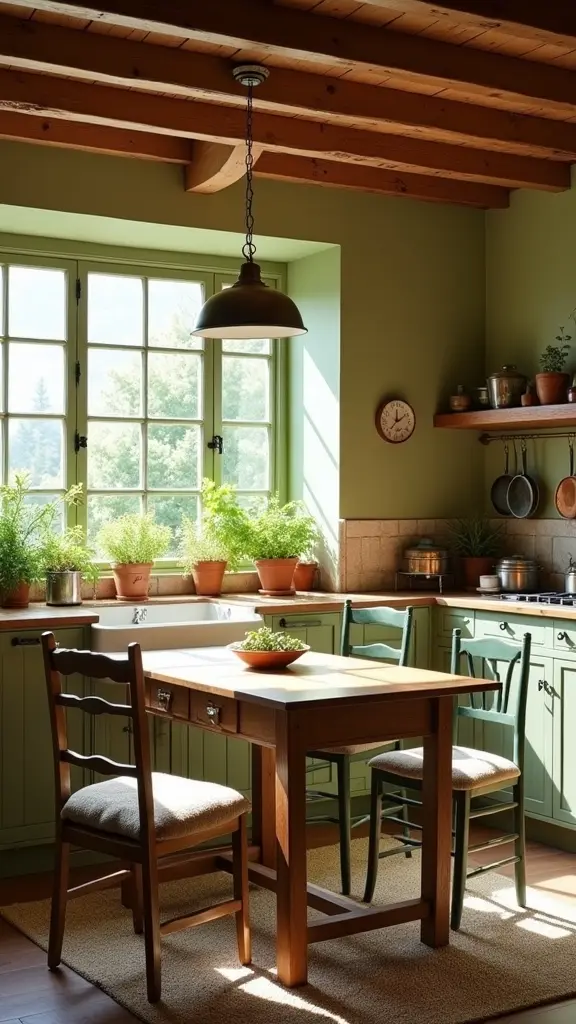
Soft green walls establish a tranquil backdrop, setting the stage for a farmhouse kitchen where layered textures introduce visual depth and tactile warmth.
Soft green walls create a soothing foundation for a farmhouse kitchen, enriched by layered textures and inviting warmth.
The interplay between soft green surfaces and natural wood elements is fundamental to achieving a cozy atmosphere. Strategic use of textures—such as rustic stone, woven fabrics, and reclaimed wood—enhances the inviting kitchen’s authenticity while maintaining a visually balanced, functional layout.
Open shelving crafted from natural wood can highlight curated dishware, fostering a lived-in, welcoming environment.
- Material Layering: Combine a robust wooden dining table with linen or cotton table linens to reinforce comfort and visual cohesion.
- Textural Accents: Integrate jute rugs, wicker baskets, and ceramic dishware to boost tactile interest and complement soft green walls.
- Functional Display: Utilize open wood shelving for both storage and decorative impact, balancing form and function.
Frequently Asked Questions
How Do I Maintain the Paint Finish on Green Kitchen Cabinets?
Maintaining green kitchen cabinet paint requires paint durability tips: gentle cabinet cleaning techniques, periodic finish restoration methods, and precise color matching advice for touch-ups. Implementing a maintenance schedule guarantees ongoing visual balance and functional layout within the kitchen environment.
What Lighting Works Best in a Farmhouse Green Kitchen?
Ideal lighting combines pendant lights for task illumination, abundant natural light for openness, and accent lighting to highlight features. Warm tones and vintage fixtures enhance visual balance, complementing the green cabinetry and promoting a functional layout with inviting ambiance.
Are Farmhouse Green Kitchens Suitable for Small Spaces?
The suitability of farmhouse green kitchens for small spaces depends on implementing small space solutions, choosing harmonious color combinations, optimizing layout tips for functional flow, incorporating smart storage ideas, and integrating design trends to maintain visual balance and maximize utility.
How Do I Prevent a Green Kitchen From Feeling Too Dark?
To prevent a green kitchen from feeling too dark, designers recommend selecting lighter green color palettes, maximizing natural light, incorporating reflective surfaces, and using open shelving. Warm accents enhance visual balance, ensuring both a functional layout and inviting atmosphere.
What Flooring Options Complement a Green Farmhouse Kitchen?
Selecting flooring that achieves visual balance in a green kitchen involves considering hardwood flooring for warmth, tile options for durability, laminate choices for affordability, cork flooring for comfort, and area rugs to enhance both function and aesthetic cohesion.
Conclusion
Incorporating green hues into farmhouse kitchens cultivates a visually balanced and inviting environment. Sage, olive, and forest green tones provide depth, while botanical wallpapers and verdant backsplashes introduce organic motifs. The interplay of vintage fixtures, brass hardware, and textured elements creates both authenticity and functional harmony. Layering these elements alongside natural materials and thoughtful layouts guarantees the kitchen feels cozy yet dynamic, achieving a timeless farmhouse aesthetic that seamlessly blends comfort, style, and practical utility.

